
Tree of Paradise carpet FATIMA AND MARY by Rev. Amber Satterwhite, ThD, aka Oiled Lamp
In Syrian Arab mythology, Fatima is the Great Goddess of the Moon and Fate. She is the source of the Sun and the virgin Queen of Heaven. She is often represented as the Tree of Paradise. Astarte is also a Syrian Moon Goddess representing the productive power of nature. More than likely, they were basically the same cultural figure, who changed names from time to time and place to place, like most other ancient, Moon Goddess figures. The Blessed Virgin Mary’s transformation from the ancient figure of Astarte into the modern role of a Christian goddess has already been well-established in other feminist theological texts (and in other Order of the Divine Mother lessons). This lesson will examine the role of Mary in Arab, Islamic culture and religious beliefs, as well as her connection to the ancient and modern goddess figure of Fatima, and what role they might both play in the evolving Arab world.
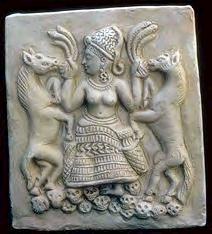
Astarte: The Lady of the Beasts. Along with Lilith she is one of the principal Elohim (this Hebrew plural word means goddesses and gods, though translated as God by biblical revisionists for the past 2,000 years) of the Semites of Phoenicia. Consort to Baal , she is here depicted with two foals in ecstatic dance, her typically upraised arms grasping serpents. She was the Great Goddess, all-powerful, creating-preserving-destroying, an embodiment of Mother Nature. Also known as Ashtoroth, in some poses she is identical with images of Kali , while in her role of virgin she is an ancient prototype of Mary.
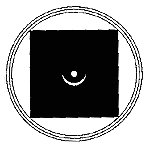 Modern Islam and Arab culture are undisputedly rigid patriarchal systems, but like most ideologies which seek to keep the Goddess out of their lives and hearts, they cannot help but betray Her inescapable presence in some of the most prominent places. Outsiders are often surprised at just how much a role the Divine Feminine plays in Muslim religion and culture. The Ka’aba, for instance, was once a temple of the Goddess, and the Black Stone now housed there as the most sacred relic of Islam is indeed an image of Al-Uzza, the Venus of Arabia. [Mouse over the black square at right for Kaaba info] The Goddess is the “hidden treasure” which all Islamic mystics seek in their unity with the Divine, and Mohammed’s reverence for the Virgin Mary and Fatima, which we shall investigate in greater depth shortly, are both additional evidence that Arab culture and Moslem religion might just be the final proving ground where the Goddess finally overcomes the constraints of cultural and religious patriarchy during her rebirth in the modern era.
Modern Islam and Arab culture are undisputedly rigid patriarchal systems, but like most ideologies which seek to keep the Goddess out of their lives and hearts, they cannot help but betray Her inescapable presence in some of the most prominent places. Outsiders are often surprised at just how much a role the Divine Feminine plays in Muslim religion and culture. The Ka’aba, for instance, was once a temple of the Goddess, and the Black Stone now housed there as the most sacred relic of Islam is indeed an image of Al-Uzza, the Venus of Arabia. [Mouse over the black square at right for Kaaba info] The Goddess is the “hidden treasure” which all Islamic mystics seek in their unity with the Divine, and Mohammed’s reverence for the Virgin Mary and Fatima, which we shall investigate in greater depth shortly, are both additional evidence that Arab culture and Moslem religion might just be the final proving ground where the Goddess finally overcomes the constraints of cultural and religious patriarchy during her rebirth in the modern era.
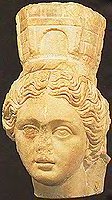
Allat, ancient Arab Goddess found in Amman, Jordan
- “In Arabia, the sun god was viewed as a female goddess and the moon as the male god. One of the moon god’s name was called Allah.” (Islam, Alfred Guillaume, 1956, p 7)
- “Allah: Originally applied to the moon; he seems to be preceded by Ilmaqah, the moon god… Allat: the female counterpart to Allah.” (A Dictionary of Non-Classical Mythology, Marian Edwardes, Lewis Spence, Allah, p. 7)
- “Allah, the moon god was married to the sun goddess. Together they produce the three goddess (the daughters of Allah), Al-Lat, Al-Uzza and Manat. All of these ‘gods’ were viewed as being the top of the pantheon of Arab deities.” (The Facts on File Encyclopedia of World Mythology and Legend, Anthony S. Mercatante, I. 61)
-
Allat, according to recent study of the complicated inspirational evidence, is believed to have been introduced into Arabia from Syria, and to have been the moon goddess of North Arabia. If this is the correct interpretation of her character, she corresponded to the moon deity of South Arabia, Almaqah, `Vadd, `Amm or Sin as he was called, the difference being only the oppositeness of gender. Mount Sinai (the name being an Arabic feminine form of Sin) would then have been one of the centers of the worship of this northern moon goddess. Similarly, al-`Uzza is supposed to have come from Sinai, and to have been the goddess of the planet Venus. As the moon and the evening star are associated in the heavens, so too were Allat and al-`Uzza together in religious belief, and so too are the crescent and star conjoined on the flags of Arab countries today. (The Archeology Of World Religions, Jack Finegan, 1952, p482-485, 492)
Voy Forum discussion of Allah, Moon God lists the above four quotes and many more.
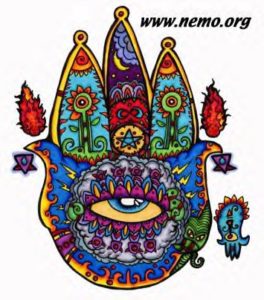 Many people may be surprised that Muslims love Mary, the mother of Jesus. In the Koran, no woman is given more attention than Mary. In fact, she is the only woman specifically named in the Koran. Of the Koran’s 114 chapters, she is among the eight people who have a chapter named after them. The nineteenth chapter of the Koran is named after her, Mariam, and the third chapter in the Koran is named after her father, Imran. The Mariam and Imran chapters are among the most beautiful chapters in the Koran. An authentic Haddith (traditional saying of Mohammed) states that, “The superiority of ‘Aisha to other ladies is like the superiority of Tharid (i.e. meat and bread dish) to other meals. Many men reached the level of perfection, but no woman reached such a level except Mary, the daughter of Imran and Asia, the wife of Pharaoh”(Bukhari 4.643). The Virgin Mary plays a very significant role in Islam, and according to the Koran is an example and a sign for all people (Koran 66:11-12).
Many people may be surprised that Muslims love Mary, the mother of Jesus. In the Koran, no woman is given more attention than Mary. In fact, she is the only woman specifically named in the Koran. Of the Koran’s 114 chapters, she is among the eight people who have a chapter named after them. The nineteenth chapter of the Koran is named after her, Mariam, and the third chapter in the Koran is named after her father, Imran. The Mariam and Imran chapters are among the most beautiful chapters in the Koran. An authentic Haddith (traditional saying of Mohammed) states that, “The superiority of ‘Aisha to other ladies is like the superiority of Tharid (i.e. meat and bread dish) to other meals. Many men reached the level of perfection, but no woman reached such a level except Mary, the daughter of Imran and Asia, the wife of Pharaoh”(Bukhari 4.643). The Virgin Mary plays a very significant role in Islam, and according to the Koran is an example and a sign for all people (Koran 66:11-12).
In the Koran, Mary’s story begins while she is still in her mother’s womb.The mother of Mary, known as St. Anne to Christians but Asia to Muslims,said: “O my Lord! I do dedicate into Thee what is in my womb for Thy specialservice: So accept this of me: For Thou hearest and knowest all things” (Koran3:35). She wanted the baby in her womb to serve only the Creator. When Marywas delivered, she said: “O my Lord! Behold! I am delivered of a female child!”(Koran 3:36). According to this account, she had expected her baby to bea male child who would grow up to be a scholar or religious leader, but Godrevealed a better plan which included the sanctified birth of a female child.Koran 3:36 continues “ and God knew best what she brought forth- ‘Andno wise is the male like the female. I have named her Mariam, and I commendher and her offspring to Thy protection from Satan, the Rejected.'” Mariamliterally means “maidservant of God,” and the Koran acknowledges that nameto be of divine origin here. In Koran 3:37, God states that He accepted Maryas her mother had asked. He made Mary grow in purity and beauty. She wasassigned to the care of a priest named Zacharias. This is interesting consideringhow few women were given this opportunity to be raised in such proximityto the Temple and its holy rites. The Koran goes on to explain that “Everytime that he entered (her) chamber to see her, he found her supplied withsustenance. He said: ‘O Mary! Whence (comes) this to you?’ She said: ‘FromGod. for God provides sustenance to whom He pleases without measure.'” (Koran3:37). Upon hearing Mary’s answer, “There did Zakariya pray to his Lord,saying: ‘O my Lord! Grant unto me from Thee a progeny that is pure: for Thouart He that heareth prayer!'” (Koran 3:38). Although his wife was barrenand he was very old, God blesses Zacharias and his wife Elizabeth with John,who grew to become John the Baptist in the Christian scriptures. Zachariaswas skeptical after the angels announced John’s birth in the Koran as wellas the Bible, and God responsed to his skepticism in the Koran in a similarway as he did in the Bible: “Doth God accomplish what He willeth” (Koran3:40). John would become a noble and chaste Prophet as the angels had predicted(Koran 3:39).
The Koran discusses Mary’s miraculous conception of Jesus as well. “Relatein the Book (the story of) Mary, when she withdrew from her family to a placein the East. She placed a screen (to screen herself) from them; then We senther Our angel, and he appeared before her as a man in all respects.” (Koran19:16-17). After seeing the angel, she said: “I seek refuge from thee to(God) Most Gracious: (come not near) if thou dost fear God.” (Koran 19:18).The angel Gabriel responded: “Nay, I am only a messenger from thy Lord, (toannounce) to thee the gift of a pure son.” (Koran 19:19). Her next responseis expected. She asked: “How shall I have a son, seeing that no man has touchedme, and I am not unchaste?” (Koran 19:20). The Angel Gabriel said: “So (itwill be): thy Lord saith, ‘That is easy for Me: and (We wish) to appointhim as a Sign unto men and a Mercy from Us.’ It is a matter (so) decreed.”(Koran 19:21). Mary then becomes pregnant.
According to Islam, Jesus is a Prophet and a Messenger. A Messenger is defined as a Prophet who is given revelation from God. Whereas the Torah was revealed to Moses, the Gospel was revealed to Jesus. Messengers are sent as a mercy,guidance, and sign from God. The Koran says about Jesus, “And God will teach him the Book and Wisdom, the Torah and the Gospel, and (appoint him) as a messenger to the Children of Israel, (with this message): ‘I have come to you, with a Sign from your Lord, in that I make for you out of clay, as it were, the figure of a bird, and breathe into it, and it becomes a bird by God’s leave. And I heal those born blind, and the lepers, and I bring thedead into life, by God’s leave; and I declare to you what ye eat, and whatye store in your houses. Surely therein is a Sign for you if ye did believe.(I have come to you) to attest the Torah which was before me. And to makelawful to you part of what was (before) forbidden to you. I have come toyou with a Sign from your Lord. So fear God, and obey me. It is God Who is my Lord and your Lord; then worship Him. This is a Way that is straight.'”(Koran 3:48-51). Jesus was sent to call people to the worship of the one,true God. Only by God’s leave was Jesus able to perform miracles.
After conceiving Jesus, Mary went away with the baby to a distant place (Koran19:22). “And the pains of childbirth drove her to the trunk of a palm-tree. She cried (in her anguish): ‘Ah! would that I had died before this! would that I had been a thing forgotten!'” (Koran 19:23). “But (a voice) criedto her from beneath the (palm-tree): ‘Grieve not! for thy Lord hath provided a rivulet beneath thee; And shake towards thyself the trunk of the palm-tree:It will let fall fresh ripe dates upon thee. So eat and drink and cool (thine)eye. And if thou dost see any man, say, ‘I have vowed a fast to (God) MostGracious, and this day will I enter into no talk with any human being.'”(Koran 19:24-26). The references here to the palm and dates are witness tothe Syrian Goddess origins of this myth; they, too, shared similar symbolism.Joseph, the magi, and the manger are not mentioned in the Koran, however.God was Mary’s only Provider. In other words, in Islam, Mary, the blessedof God, is a single mother. Muslims do not accept the virgin birth of Jesusas evidence of Jesus’ divinity. “The similitude of Jesus before God is asthat of Adam; He created him from dust, then said to him: ‘Be.’ And he was.”(Koran 3:59). Adam’s creation is considered even more miraculous becausehe was born without father or mother.
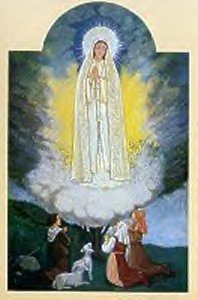 When Mary finally brings baby Jesus to her people, they say: “O Mary! truly a strange thing has thou brought! O sister of Aaron! Thy father was not a man of evil, nor thy mother a woman unchaste!” (Koran 19:27-8). Mary then points to the baby. They say: “How can we talk to one who is a child in the cradle?” (Koran 19:29). Then a miracle occurs that is not mentioned in the Bible. In defense of his mother, Jesus says: “I am indeed a servant of God. He hath given me revelation and made me a prophet; And He hath made me blessed wheresoever I be, and hath enjoined on me Prayer and Charity as long as I live; (He hath made me) kind to my mother, and not overbearing or unblest; So peace is on me the day I was born, the day that I die, and the day that I shall be raised up to life (again)!” (Koran 19:30-33). The virgin birth of Jesus was a sign. “And (remember) her who guarded her chastity: We breathed into her of Our spirit, and We made her and her son a sign for all peoples.” (Koran 21:91). Of course, Muslims do not believe in the concept of the Holy Trinity (Koran 5:73), nor do they believe that God is Jesus (Koran 5:72). On the Day of Judgment portrayed in the Koran, when Jesus is asked if he had called people to worship him and his mother as two gods, Jesus says: “Glory to Thee! never could I say what I had no right (to say). Had I said such a thing, Thou wouldst indeed have known it. Thou knowest what is in my heart, Thou I know not what is in Thine. For Thou knowest in full all that is hidden.” (Koran 5:116). Muslims believe that people should not worship any of God’s creation, including Jesus and Mary, nor should we assign any of God’s creation His divine attributes and characteristics. “He is God the Creator, the Maker, the Shaper. To Him belong the Names Most Beautiful. All that is in the heavens and the earth magnifies Him; He is the All-Mighty, the All-Wise.” (Koran 59:24). According to Islam, although God can do all things, He only does things that are consistent with His fundamental nature, and begetting a son is not consistent with God’s magnificent nature (Koran 19:92, Koran 19:35). Also consistent with His fundamental nature, however, is forgiveness. Although Adam and Eve could no longer live in Paradise after the Fall, God forgave Adam and Eve for their sin after they sincerely repented (Koran 2:35-37). This makes all of us responsible for our own deeds, and means we will not be punished for the deeds of another person (Koran 53:38-42). Therefore, Muslims reject the doctrine of original sin. Although Adam and Eve were punished, God would still be merciful by sending Guidance to mankind, “We said: ‘Get down all of you from this place (the Paradise), then whenever there comes to you Guidance from Me, and whoever follows My Guidance, there shall be no fear on them, nor shall they grieve.'” (Koran 2:38).
When Mary finally brings baby Jesus to her people, they say: “O Mary! truly a strange thing has thou brought! O sister of Aaron! Thy father was not a man of evil, nor thy mother a woman unchaste!” (Koran 19:27-8). Mary then points to the baby. They say: “How can we talk to one who is a child in the cradle?” (Koran 19:29). Then a miracle occurs that is not mentioned in the Bible. In defense of his mother, Jesus says: “I am indeed a servant of God. He hath given me revelation and made me a prophet; And He hath made me blessed wheresoever I be, and hath enjoined on me Prayer and Charity as long as I live; (He hath made me) kind to my mother, and not overbearing or unblest; So peace is on me the day I was born, the day that I die, and the day that I shall be raised up to life (again)!” (Koran 19:30-33). The virgin birth of Jesus was a sign. “And (remember) her who guarded her chastity: We breathed into her of Our spirit, and We made her and her son a sign for all peoples.” (Koran 21:91). Of course, Muslims do not believe in the concept of the Holy Trinity (Koran 5:73), nor do they believe that God is Jesus (Koran 5:72). On the Day of Judgment portrayed in the Koran, when Jesus is asked if he had called people to worship him and his mother as two gods, Jesus says: “Glory to Thee! never could I say what I had no right (to say). Had I said such a thing, Thou wouldst indeed have known it. Thou knowest what is in my heart, Thou I know not what is in Thine. For Thou knowest in full all that is hidden.” (Koran 5:116). Muslims believe that people should not worship any of God’s creation, including Jesus and Mary, nor should we assign any of God’s creation His divine attributes and characteristics. “He is God the Creator, the Maker, the Shaper. To Him belong the Names Most Beautiful. All that is in the heavens and the earth magnifies Him; He is the All-Mighty, the All-Wise.” (Koran 59:24). According to Islam, although God can do all things, He only does things that are consistent with His fundamental nature, and begetting a son is not consistent with God’s magnificent nature (Koran 19:92, Koran 19:35). Also consistent with His fundamental nature, however, is forgiveness. Although Adam and Eve could no longer live in Paradise after the Fall, God forgave Adam and Eve for their sin after they sincerely repented (Koran 2:35-37). This makes all of us responsible for our own deeds, and means we will not be punished for the deeds of another person (Koran 53:38-42). Therefore, Muslims reject the doctrine of original sin. Although Adam and Eve were punished, God would still be merciful by sending Guidance to mankind, “We said: ‘Get down all of you from this place (the Paradise), then whenever there comes to you Guidance from Me, and whoever follows My Guidance, there shall be no fear on them, nor shall they grieve.'” (Koran 2:38).
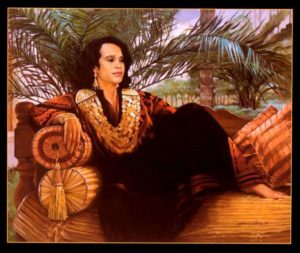
Fatima, MuslimPrincess
When people hear the term Islam, they naturally tend to think of the organized religion of Islam which started in the 7th century CE with the Prophet Mohammed. However, in Arabic the word Islam comes from the root “salema” which means peace, purity, submission, and obedience. In the religious sense, Islam means peace and purity achieved by submitting to the will of God and obedience to His law. Muslims are “those who submit.” Muslims believe that all those who submitted to the will of God in line with divine revelation received before the advent of formal Islam with the prophet Mohammed, were themselves also Muslim. So coming from this understanding, Muslims believe that they are part of one continuing faith community with Jesus and Mary. Mary, Jesus, and the disciples were all “Muslims” because they submitted to God. “Behold! the angels said: ‘O Mary! God hath chosen thee and purified thee – chosen thee above the women of all nations. O Mary! worship thy Lord devoutly: Prostrate thyself, and bow down (in prayer) with those who bow down.'” (Koran 3:42-43). 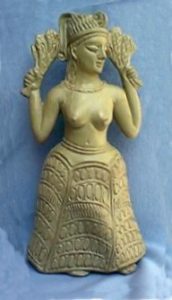 Thus, Astarte’s evolution from the Great Goddess of the Moon to the lowly handmaiden of God completed the subjugation of the Goddess to the patriarchal Demiurge, yet still maintained a basic element of the Divine Feminine within Moslem religion.
Thus, Astarte’s evolution from the Great Goddess of the Moon to the lowly handmaiden of God completed the subjugation of the Goddess to the patriarchal Demiurge, yet still maintained a basic element of the Divine Feminine within Moslem religion.
After acting as Goddess to the peoples of Arabia in various forms for millennia,Fatima underwent a similar transformation when the monotheism of Mohammedsubjugated the Goddess to the all-consuming Demiurge. Naturally, Fatima wasa popular name for girls in Arab culture long before Islam, but it gainedeven greater significance after the prophet Mohammed named his own daughterFatima. Mohammed is reputed to have once said after his daughter Fatima’sdeath that, “she has the highest place in heaven after the Virgin Mary.”This is intriguing when we realize that Fatima, Portugal got its name duringthe Arab Moors’ occupation of Portugal. The village of Fatima was given theIslamic name of the well-loved Princess of the nearby Castle of Ouremn. Shedied at an early age after marrying the Count of Ourem and converting toCatholicism. Baptized with the Christian name of Oureana, her birth namewas Fatima, after Mohammed’s reverenced Moslem daughter, who is herself namedafter the original Moon Goddess of Syria. It is a fact that Moslems fromvarious nations, especially from the Middle East, make so many pilgrimagesto Our Lady of Fatima’s Shrine in Portugal that Portuguese officials haveexpressed some concern over it. The combination of an Islamic name and Islamicdevotion to the Blessed Virgin Mary is evidently a great attraction to manyMoslems, and signals the unifying power the Goddess exercises over all theworld’s differing religious faiths.
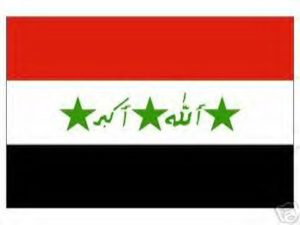 The Iraqi flag, which flies as the banner of one of the foremost Arab countries on Earth, is another very interesting set of symbols in a seemingly unlikely place. The three equal horizontal bands of red, white, and black recall the triple Goddess (Mother, Maiden, Crone). The three green five-pointed stars in a horizontal line, centered in the white band, suggest the life-giving knowledge the first woman gave to the first man, supposedly here at this place in ancient Mesopotamia. The phrase written in green Arabic script next to the stars, ALLAHU AKBAR (God is Great) was only added in January 1991 during the Persian Gulf crisis, when Saddam Hussein, fashioning himself after the patriarchal God or Demiurge figure, consumed with his own overblown sense of ego, sought to declare his supremacy over the Iraqi people in front of all the world. This symbolism is interesting for our discussion, not only because it is a fine representation of the basic struggle of the Goddess to resume her proper role in the consciousness of the Middle East, but also as an illustration of her rising triumph in that struggle. I write this now, only a few days after Saddam Hussein’s capture and arrest by US forces (Dec. 2003). The people of Iraq are now finally free of the tyrant which sought to stamp “his” name over that of the people’s true sovereign. Like the tiny green words which seem lost in the flag’s wider field, the demiurge failed to fill the role he tried to usurp from his Mother.
The Iraqi flag, which flies as the banner of one of the foremost Arab countries on Earth, is another very interesting set of symbols in a seemingly unlikely place. The three equal horizontal bands of red, white, and black recall the triple Goddess (Mother, Maiden, Crone). The three green five-pointed stars in a horizontal line, centered in the white band, suggest the life-giving knowledge the first woman gave to the first man, supposedly here at this place in ancient Mesopotamia. The phrase written in green Arabic script next to the stars, ALLAHU AKBAR (God is Great) was only added in January 1991 during the Persian Gulf crisis, when Saddam Hussein, fashioning himself after the patriarchal God or Demiurge figure, consumed with his own overblown sense of ego, sought to declare his supremacy over the Iraqi people in front of all the world. This symbolism is interesting for our discussion, not only because it is a fine representation of the basic struggle of the Goddess to resume her proper role in the consciousness of the Middle East, but also as an illustration of her rising triumph in that struggle. I write this now, only a few days after Saddam Hussein’s capture and arrest by US forces (Dec. 2003). The people of Iraq are now finally free of the tyrant which sought to stamp “his” name over that of the people’s true sovereign. Like the tiny green words which seem lost in the flag’s wider field, the demiurge failed to fill the role he tried to usurp from his Mother.
During the last few millennia, the Goddess has made her temporary journey into the underworld in order to participate in her cycle of regeneration and renewal. While her children could not see her behind the veil of the spirit world, pretenders to her power arose during her absence and made their influence felt. In the coming days, as justice is finally done against the man who murdered, tortured, and deprived the Iraqi people for so long, they will at last be free to invoke those ancient and life-sustaining energies of the Goddess back into their land. The Goddess cannot and will not be denied. As in all patriarchal societies, she has been there all along, slumbering, waiting for the time to be reborn and reclaim her people, and that time is now. It makes me wonder, now that the last surviving element of the Hussein regime has fallen, will Iraq lead the rest of the Arab world to remember and reclaim their legacy of the Divine Feminine through the egalitarian institutions of democracy? Will their banner finally proclaim its message to the world? Will this time not only be remembered as the final fall of a malevolent dictator but the turning point when fundamentalist, patriarchal Arabs finally loosed their grip on Islam and the Mother began to return to make the desert bloom as the rose again? I hope so.
In the meantime, as Initiates in the various sacred Orders of esoteric Christianity, we hold a sacred trust to protect the Divine Feminine and pour out her waters over a parched and thirsty world. Our connection with the ancient Goddesses Astarte and Fatima, through her modern incarnations of Mary Magdala and Mary the Blessed Mother in particular, give us a powerful connection with the Muslim world to assist in their spiritual and cultural healing and reclamation. Our prayers of the Rosary and other Marian venerations can combine with the reverence of Muslims, to do our part in the healing of the Middle East, as well as the rest of our world.
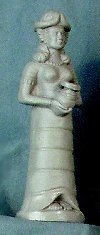
Queen Ishtar / Inanna is holding the proverbial alabaster jar. The priestesses of Ishtar were said to sacrifice the God-King for the rejuvenation of the land each year. She is the Goddess the earliest Arabs worshipped. The nearly extinct non-Muslim Marsh Arabs of Iraq, persecuted by Saddam Hussein, still “remember” her. Later Christian goddesses especially the Magdalen, were based on Ishtar and Inanna.
LESSON QUESTIONS: Please copy and paste, add your answers intoan email to the Mystery School and send with subject line, “Shemsu Fatima answers from ___________ (yourmagikal name)”.
1. Fatima is the Great Goddess of the ______ and ______. She is the source of the ______, and the virgin ___________.
2. How is Fatima often represented?
3. Who is another ancient Syrian goddess who is mythologically synonymous with Fatima?
4. What modern figure do many feminist theologians believe was inspired by Astarte?
5. The Ka’aba was once a temple of ________, and the Black Stone now housed there as the most sacred relic
of Islam is an image of _________.
6. What is the “hidden treasure” of Islam?
7. Who does the Koran name as an example and a sign for all people?
8. Please briefly describe at least two examples of references to Mary inthe Koran.
9. Where did Mary give birth to Jesus according to the Koran?
10. Do Muslims accept the virgin birth of Jesus by Mary?
11. Do they believe the virgin birth makes Jesus the Son of God and partof the Godhead?
12. What does the word “Muslim” mean?
13. What does the name “Mary” mean?
14. How did the village of Fatima, Portugal get its name?
15. Of whom did the Prophet Mohammed say, “she has the highest place in heavenafter the Virgin Mary”?
16. Why do many Moslems make pilgrimages to Our Lady of Fatima’s Shrine inPortugal?
17. How is the Iraqi flag symbolic of the Goddess?
18. During the last few millennia, the _________ has made her temporary journeyinto the ____________ in order to participate in her cycle of ___________and________.
19. What is one thing we can do as esoteric Christians to invoke the peaceof the Goddess into the Middle East?

